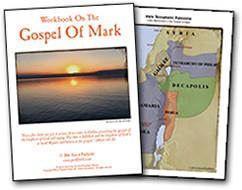Free Bible Class Book On Mark

We are pleased to announce a new Bible study guide for the Gospel of Mark. This free book by David Padfield contains an outline of the book and questions for each section. Padfield also created a colorful map of the cities in Israel that were mentioned in the book of Mark.
Christians often wonder why there are four accounts of the life of Christ recorded in the New Testament. The basic answer is that the four gospels (Matthew, Mark, Luke, and John) all tell us the same story, but from four different viewpoints and to four different audiences. The gospel writers all tell us the same basic story about the life of Christ. However, while one writer might choose to emphasize the parables of Jesus, another writer might skip over the parables and dwell on the nature and character of our Lord. Putting all four gospel accounts together gives us a fuller and richer portrait of the life and work of Jesus the Messiah.
The gospel of Mark was written to a Roman audience. If one verse could reflect the message of the book, it would be this: "For even the Son of Man did not come to be served, but to serve, and to give His life a ransom for many" (Mark 10:45). In the book of Mark, Jesus is presented as the ideal servant. Unlike Matthew, Mark does not give us the genealogy of Christ, for a servant's genealogy is not important.
Since Mark was not writing to a Jewish audience, he had to explain Jewish customs and settings to his readers. Matthew tells us of the question the scribes and Pharisees had over the fact the disciples of Jesus did "not wash their hands when they eat bread" (Matt 15:1–11). When Mark tells the same story, he has to explain the washing of hands was a ceremonial cleansing, not the washing of dirt off the body. "For the Pharisees and all the Jews do not eat unless they wash their hands in a special way, holding the tradition of the elders. When they come from the marketplace, they do not eat unless they wash. And there are many other things which they have received and hold, like the washing of cups, pitchers, copper vessels, and couches." (Mark 7:3-4)
When Jesus predicted the destruction of the Temple, Mark tells us that Jesus "sat on the Mount of Olives opposite the temple" (Mark 13:3). Every Jew knew the Mount of Olives was "opposite the temple," but Roman readers would have had no idea about its location.
Mark also has to explain the day of Unleavened Bread was "when they killed the Passover lamb," something every Jew would have known since birth, but about which a Roman would have been unfamiliar.
Download Your Copy Now…
The Bible Class Book on Mark is a free book you can download and print out for your classes (23 pages; PDF file size: 827k). All of the books on this website may be reprinted by individuals, churches, schools, and seminaries in their teaching programs. However, these class books may not be altered in any way, and they must be given away at no charge.
